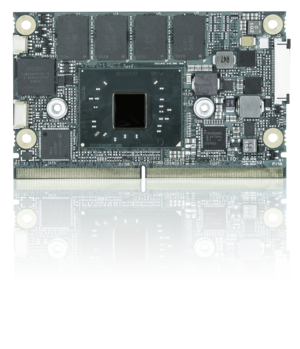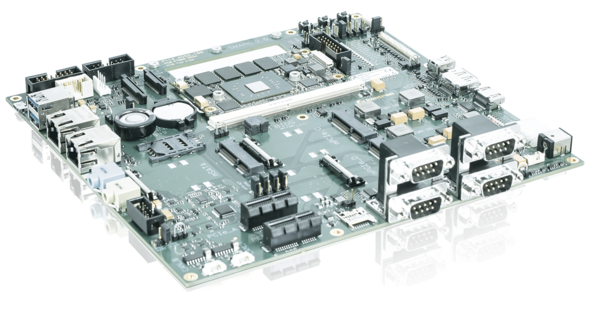For support related inquires, please contact our support team:
Contact SupportSuccessful Form Factor SMARC 2.0: Where Does It Stand Today?

The new SMARC Standard 2. was introduced in June 2016. Besides important improvements and technical updates, it also threw open the door to the Internet of Things (IoT).
Almost one year later, it is now time to assess the acceptance of the Smart Mobility Architecture Standard 2.0.
Connected high-performance embedded systems have become the norm in many industrial and everyday products. These mini computers make many IoT applications possible in the first place as they are extremely compact, very robust, and come with enormous performance reserves. Evaluating and analyzing the data they collect can unveil optimization potentials for companies and thus contribute directly to corporate success.
Many embedded systems are based on SMARC, a standard form factor for Computer-on-Modules (COMs). SMARC is used from automation solutions to graphic and image-centered devices that require very low energy consumption and have to withstand extreme environmental conditions. The modules serve as building blocks for very small portable handheld devices as well as larger systems, whose energy consumption should not exceed a few watts while still maintaining high computing performance. SMARC modules therefore offer unimagined opportunities that are far from exhausted.
Innovation Driver SMARC
Since its introduction in 2013, the SMARC standard is one of the innovation drivers in the ultra-low-power embedded market. Development of the small boards advances rapidly. The new version 2.0 of the SMARC embedded computer format was introduced in June 2016 by the SGET (Standardization Group for Embedded Technologies e.V.) Standard Development Team 0.1 (SDT 0.1). It features important innovations that make the platform even more interesting, especially for modern IoT applications.
Kontron presented the SMARC Evaluation Carrier 2.0 for ultra-low-power Computer-on-Modules (COMs) at embedded world in Nuremberg in March 2017. The new evaluation carrier board offers a head start to designing embedded applications based on the SMARC 2.0 platform. The SMARC Evaluation Carrier 2.0 thus is the ideal foundation for the development of already available SMARC-sXAL modules with the new Intel Atom processor family, for future SMARC modules and other individual solutions. It also gives an extremely broad choice of interfaces.
With the new Kontron SMARC Evaluation Carrier 2.0, developers only have to choose the SMARC module that best fits the desired application requirements, set it up, and start working on the latest technological level. Kontron will release a starter kit based on the SMARC Evaluation Carrier 2.0 in the near future. It will be immediately deployable according to the plug-and-play principle and – like its predecessor that is based on the first SMARC version – come equipped with all necessary components to facilitate evaluating processors.
The First SMARC 2.0 Goal: Compatibility
Notably, the SMARC 2.0 specifications offer a new pin assignment as well as improved processor interfaces that harmonize with the original 2013 standard set for low-profile form factor modules. Various rarely used and partially outdated interfaces have, in turn, been removed.
The goal in updating the standard was to realize a new pin assignment while remaining as compatible as possible with the V1.1 assignment. Accordingly, selected V1.1 pins that had seldom been used found a new purpose in SMARC 2.0, permitting new interface detection. The possibility of damages from using older modules in V2.0-compatible carrier boards or the other way around should be ruled out in any case.
Today, however, the SMARC connectors’ 314 contacts do not only have to support ARM and be compatible with this processor architecture but with x86 as well – two distinctly different SoC architectures. The connector, for example, has to ensure a high signal integrity degree for ARM while supporting MIPI display interfaces, camera interfaces, multiple SPI connections, and SDIO interfaces. At the same time, it has to be compatible with x86 requirements such as, for example, numerous USB and PCI Express lines.
SGET has answered these challenges with an update of the original specifications based on valuable feedback from many developers and users over the last three years.
SMARC Is Not a Standard Set in Stone
The latest specification and the first products based on it prove again that the SMARC standard is not, and cannot be, a rigid entity. A uniform ARM-COM standard for the industry is still necessary as the different interfaces of ARM and x86 often require specific implementation; but new interfaces need a future-oriented pinout. The fast development cycle and rapid market acceptance show that the SMARC approach has hit a customer nerve. However, such a standard has to be alive. It must keep up with the industry and react to new market requirements. Without a doubt, SMARC 2.0 will be the foundation for many pioneering and highly developed applications in the coming years.
Kontron will remain a SMARC innovation driver. It has already introduced the first SMARC 2.0 Computer-on-Module based on the latest Intel processor generation in November 2016. Like all current Kontron embedded boards and controllers, it is IoT-ready and profits from deep software integration.
SMARC 2.0 Modules Are On The Way Up
Besides the SMARC Evaluation Carrier 2.0, Kontron has introduced its planning for the coming SMARC-2.0-based boards in March 2017. The Kontron SMARC-sXAL modules with the latest Intel processors (Atom, Celeron, Pentium) are already available. Equipped with current image processing and graphics capabilities, the Kontron SMARC-sXAL offers comprehensive real-time computing power in an energy-efficient and standardized Computer-on-Module form factor. Users profit from significantly increased computing power, an impressive performance-per-Watt ratio, and long-term availability like all Kontron embedded solutions. What is more, the company has announced a SMARC 2.0 product line with NXP i.MX7 low-performance processor optimized for networking tasks at the world`s leading embedded trade show embedded world 2017; it will be available soon. Another version with ARM processors that meets demanding graphic tasks with higher performance is in the planning stages. All new Kontron SMARC 2.0 modules can be equipped with the original security solution APPROTECT which protects data and application integrity end to end. With Kontron APPROTECT LICENSING, new business models such as licensing or pay-per-use can easily be implemented.

//The new evaluation carrier board from Kontron is based on the current SGET SMARC 2.0 specifications
A look at the Kontron product roadmap shows that SMARC 2.0 has already arrived at the vendors. With the technical innovations, it will not be long until customers can enjoy the advantages of the updated specification as well.
Download this Article
